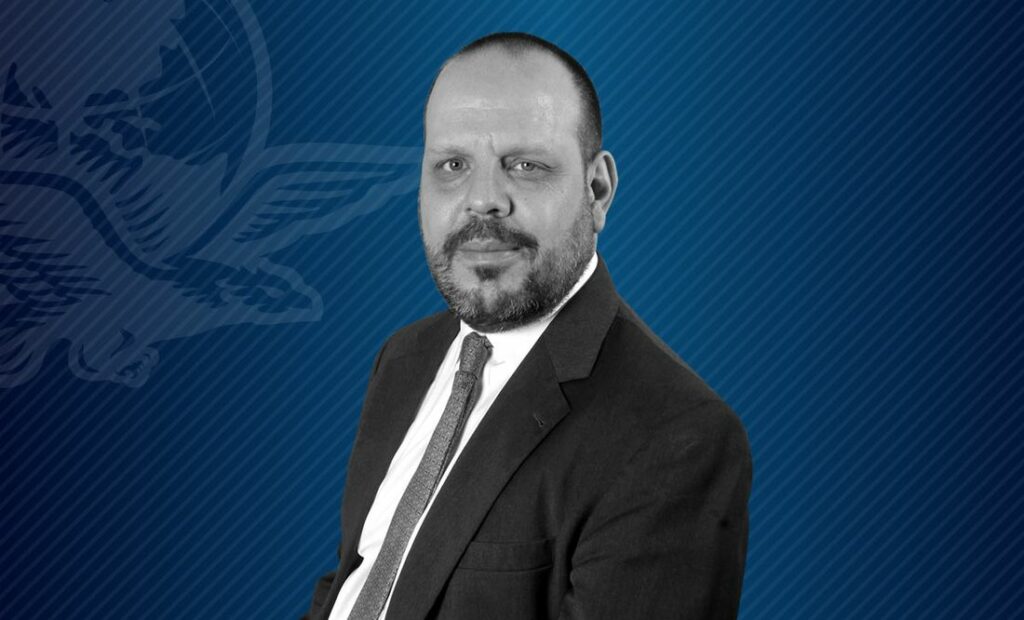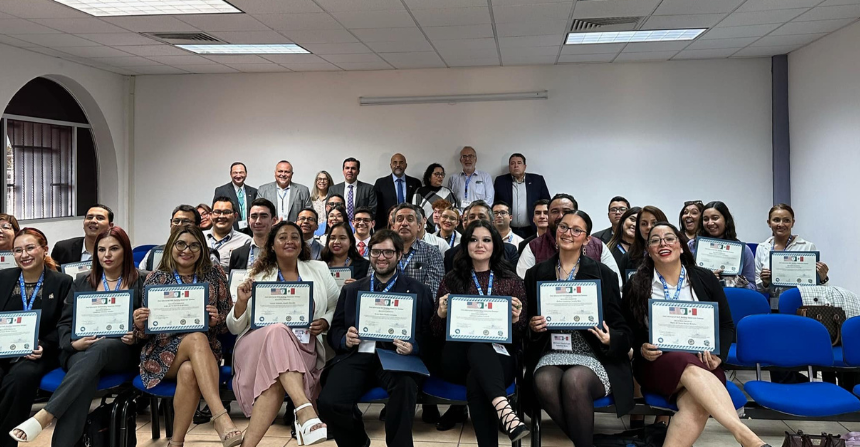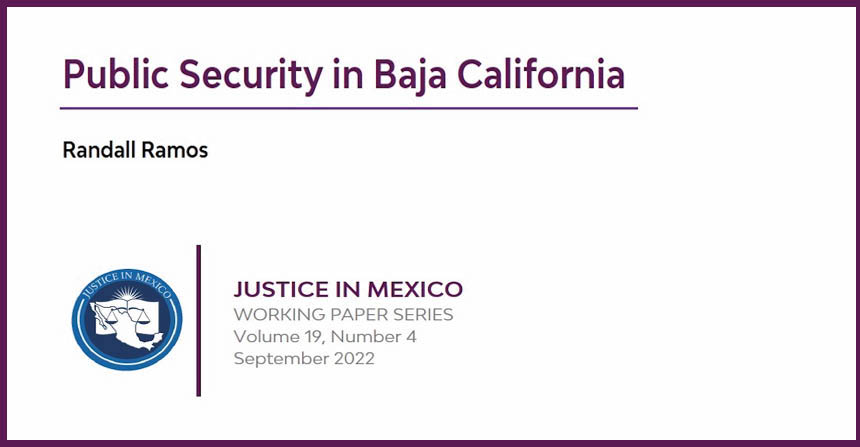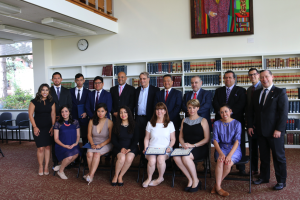
7/22/16 (written by rkuckertz) —From July 4 to July 15, six faculty members and four students from the UNAM Law School (Universidad Nacional Autónoma de México Facultad de Derecho) were selected to participate in the second of three study trips to the United States in order to learn about the U.S. Criminal Justice System as a part of the Oral-Adversarial Skill-building Immersion Seminar (OASIS). This program was made possible by a grant from the U.S. State Department’s Bureau of International Narcotics and Law Enforcement Affairs. During their visit to Boston, UNAM faculty and students had the opportunity to meet and learn from prominent public officials and legal experts in the Boston community such as former Boston Police Commissioner Paul Evans, prosecutor John Capin, defense attorney and Harvard professor Andrew Crespo, DOJ Assistant Deputy Bruce Ohr, Director of the Organized Crime division for the U.S. Attorney Generals Office Cynthia Young, prosecutor Ted Merritt, District Judge Patti Saris, defense attorney Martin Weinberg, and federal prosecutor Fred M. Wyshak Jr.
With the assistance and direction of OASIS Regional Coordinator and Harvard professor Philip Heymann, each of these presenters met with the group of UNAM visitors either at Harvard Law School or at the federal courthouse in downtown Boston. Over the course of the study trip’s two weeks, Professor Heymann encouraged OASIS participants to dialogue with the presenters, providing a platform for professors and students to compare elements of the U.S. criminal justice system with the Mexican legal system and its recent implementation of the New Criminal Justice System (Nuevo Sistema de Justicia penal, NSJP).
The group from the UNAM Law School began the program at Harvard Law School on Tuesday, July 5 with an inauguration ceremony led by OASIS Director Dr. David Shirk, OASIS Field Coordinator Laura Calderón, and Professor Heymann. Following the inaugural ceremony, Professor Heymann hosted a screening of a specially edited version of the 1979 ABC documentary, “The Shooting of Big Man: Anatomy of a Criminal Case,” based on a Harvard law research project by Harvard Law School alum and Seattle criminal defense attorney Eric Saltzman. Following the film viewing, Professor Heymann led a discussion on the elements of the criminal case depicted in the documentary.
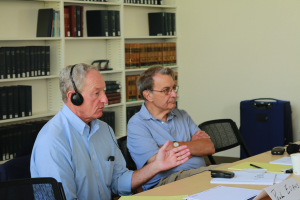
On Wednesday, July 6, the morning began with a group discussion on the role of the police in criminal investigations led by former Boston Police Commissioner Paul Evans. Mr. Evans, who now runs a consulting firm, served as Boston’s Police Commissioner for ten years and shared many reflections on his experience with the group. Specifically, Mr. Evans identified two critical elements to a successful national police force: strong leadership within police operations and accountability to the general public. He stressed the importance of properly training incoming police officers, supplying them with the necessary equipment, and compensating police officers fairly based on their responsibilities, as these actions often contribute to a more accountable police force. Mr. Evans concluded the discussion with an analysis of an incident that occurred in 2014 in Chicago, Illinois in which a police officer fatally shot a teenager sixteen times. Mr. Evans discussed how in this case, there was a collective failure of leadership by the police and many public officials who attempted to hide the events of that evening. Mr. Evans presented this case as a counterexample to how police leadership should respond to such acts of “egregious excessive force”, stressing that the leadership’s lack of accountability in this case resulted in a heightened sense of public mistrust of the police.
In the afternoon, the group watched the film 12 Angry Men, which depicted the members of a jury deliberating following the closing argument of a murder trial. The film illustrated the role of the jury in U.S. criminal trial proceedings by demonstrating how each of the twelve jurors interpreted the evidence presented in court and how each of them came to a determination based on their individual interpretations. As Mexico’s new criminal justice system does not feature jury trials, this film presented a comparative picture of how criminal trials are decided in the United States as opposed to in Mexico’s new system. Following the film, Professor Philip Heymann initiated a discussion with the participants surrounding the process of juror selection and the role of the jury throughout the trial.
On Thursday, July 7, Assistant U.S. Attorney John Capin spoke to the group regarding the role of the prosecution in U.S. criminal cases. Mr. Capin separated the prosecution’s role into four specific areas—investigation, accusation, trial, and appeals. He first explained the distinction between cases that begin with the detention of the accused and cases that begin without detention. Mr. Capin then explained the role of the prosecutor in determining the charges brought against the accused. Specifically, the prosecutor often possesses a wide range of discretion in selecting the charges that will be brought against the defendant. However, as Mr. Capin clarifies, the majority of these cases will not be brought to trial; instead, approximately 97% of cases are decided by negotiated settlements between the prosecution and the defense. The group then engaged in a brief discussion regarding the role of the prosecutor in the trial and the subsequent appeals process, after which Mr. Capin answered the group’s various questions concerning the prosecution’s role in negotiated settlements and the trial.
In the afternoon session, Program Coordinator Octavio Rodríguez presented Justice in Mexico’s past publications and various ongoing projects. He described the mission of Justice in Mexico and the origins of the OASIS program, which is made possible by a grant from the U.S. State Department as part of the Mérida Initiative.
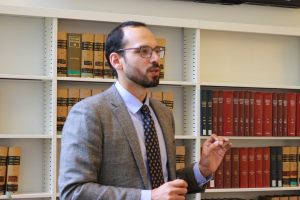
On Friday, July 8, Harvard professor and defense attorney Andrew Crespo presented to the group of UNAM professors and students regarding the role of the defense. He initiated the discussion with an overview of the United States federal system, distinguishing the local, state and federal legal systems as independent entities with separate corresponding legal processes. Professor Crespo then discussed the landmark case, Gideon v. Wainwright (1963), which established the accused’s right to legal representation. Professor Crespo also elaborated on the defense attorney’s role in representing the accused. Specifically, he emphasized that it is the defense attorney’s responsibility to provide a “holistic defense” to the client, taking into account all sociological factors—such as mental health and socioeconomic status—that may assist the defense attorney in understanding the client. Professor Crespo concluded with an overview of the defense attorney’s role throughout the legal process, from the initial meeting with the client to the trial and subsequent sentence.
The second week of the program began with a presentation by Program Coordinator Octavio Rodríguez on the results of a new survey administered by Justice in Mexico’s Justiciabarómetro project. One of the primary objectives of this project is to “take the pulse” of Mexico’s justice system through surveys of its judicial operators. As Mr. Rodríguez explained to the group, this most recent study was made possible by a research grant from the MacArthur Foundation. The survey, implemented over the course of several months from April to June 2016, sought to determine the perceptions of judges, public defenders, public prosecutors, and other judicial actors of the current judicial system. Mr. Rodríguez shared some of the initial results of the study, noting that 89% of those surveyed considered themselves prepared to work within the new judicial system. He also shared that 50% of survey participants reported employing alternative solutions, such as mediation and negotiation, rather than litigation in a trial setting. However, Mr. Rodríguez shared that this figure must reach at least 90% in order for the new judicial system to be completely functional.
Following Mr. Rodríguez’s presentation, Catherine Peshkin of the Harvard Law School LLM Office visited the group in order to discuss requirements for admission into Harvard’s LLM program for foreign lawyers. Following Ms. Peshkin’s presentation, Assistant Deputy Bruce Ohr of the Department of Justice (DOJ) discussed his role in overseeing the Organized Crime Drug Enforcement Task Force (OCDETF). Specifically, he explained that the OCDETF does not deal directly with criminal cases. Instead, this task force provides funding to various agencies such as the DEA and FBI in order to allow them to investigate large organized crime cases and to collaborate with other agencies, including the DOJ. Mr. Ohr continued by elaborating on the various ways in which the United States and Mexico engage in intelligence sharing and collaborative efforts in order to investigate criminal cases related to organized crime. He also discussed how the NSJP will impact this ongoing collaboration, referencing various investigative processes and bilateral policies. Mr. Ohr concluded by asking OASIS participants to reflect on how they have been trained for the judicial reform and how this training has impacted their work.
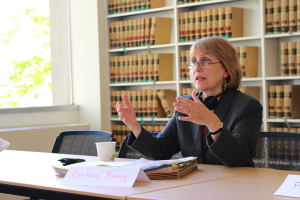
The following morning, on July 12, participants met with Cynthia Young, the Director of the Organized Crime division for the U.S. Attorney General. Ms. Young started the day with a discussion of organized crime in Mexico. She discussed the origins of drug cartels in Mexico and how the cartels’ modus operandi has shifted as a result of local disputes. Ms. Young then presented a comparative picture of organized crime in the United States, examining its origins and evolution throughout the twentieth century and into the modern era. She concluded by discussing how the federal government typically investigates and prosecutes such crimes.
In the afternoon, the group listened to a presentation by prosecutor Ted Merritt regarding the prosecution of police charged with abusing their authority in the United States. Mr. Merritt opened the dialogue by explaining the divide that exists with regard to public perception of police. While the majority of white, middle-class Americans believe the police to be trustworthy, this is not the case for Black Americans. He also referenced recent events that have sparked national controversy, such as the 2014 Ferguson, Missouri police shooting of Michael Brown, an unarmed Black teenager, and the 2014 shooting of 17-year-old Laquan McDonald in Chicago, in order to explain how a lack of leadership and proper accountability in the police force often lead to violations of constitutional civil liberties. Mr. Merritt also elaborated upon the prosecution of such cases, discussing how they are brought to trial and the manner in which they are prosecuted. Following the presentation, Professor Heymann initiated a discussion regarding police abuse in Mexico and how it is handled under the law. Participants furthered the dialogue by discussing how the NSJP reforms seek to improve training programs for police officers and the general professionalization of the police force in Mexico.
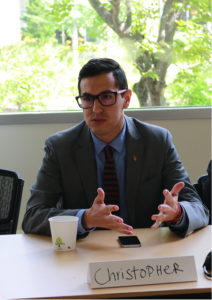
On the morning of July 13, participants traveled to the federal courthouse in downtown Boston in order to attend a sentencing hearing. Immediately after, Chief U.S. District Judge and Chair of the U.S. Sentencing Commission Patti Saris spoke to the group about federal sentencing in the United States, explaining that sentencing guidelines are primarily linked to mandatory minimum sentences for the corresponding crime. From there, the judge takes an incremental approach to sentencing, taking into account all crimes that were committed and their individual sentences to create a single sentence. For instance, as federal sentencing guidelines employ a tiered point system with each crime corresponding to a unique number of points, the man being sentenced at the hearing received a 2-point deduction for pleading guilty to his crimes, but he failed to receive a 3-point deduction because he ran away and subsequently committed further crimes. As a result, Judge Saris determined the final sentence based on a figure that accounted for each of these circumstances.
Following the sentencing hearing, defense attorneys Martin Weinberg and Robert Goldstein attended a lunch session with the group, providing background on the motion to suppress hearing that the group would witness in the afternoon as a part of a tax evasion case. Specifically, Mr. Weinberg’s primary objective as the defendant’s attorney was to invalidate the affidavit that several informants had submitted, citing several mistakes of fact within the affidavit and emphasizing the informants’ vested interest in the outcome of the case.

On July 14, OASIS Training Director Janice Deaton visited the group at Harvard Law School in order to lead a “Train the Trainer” session on teaching oral trial skills. Ms. Deaton guided the participants through the training, allowing each individual to present a section of an oral trial to a partner (opening statement, direct examination by plaintiff, cross-examination by defendant’s attorney, direct examination by defendant’s attorney, closing arguments) while another participant practiced offering effective critiques to the other.
Following Ms. Deaton’s training session, federal prosecutor Fred M. Wyshak Jr. visited the group in order to discuss how corruption cases are investigated and prosecuted in the federal justice system. Specifically, Mr. Wyshak discussed the importance of criminal informants in investigating crimes of corruption and how prosecutors use this intelligence to build a criminal case. He also described the various challenges that the government faces in investigating corruption cases.
On July 15, the last day of the OASIS Boston Study Trip, UNAM faculty and students participated in the official closing ceremony at the Harvard Law School. In attendance were OASIS Director Dr. David Shirk, as well as UNAM Law School representative Miguel González and UNAM Law School Dean Dr. Raúl Juan Contreras Bustamante. Each addressed the group, emphasizing the crucial role that the participants play in contributing to the future of Mexico’s transitioning judicial system. UNAM representatives Mr. González and Dr. Contreras also highlighted the importance of the ongoing collaboration between the United States and Mexico, especially in the context of Mexico’s judicial reform. Immediately following these comments, each participant was personally congratulated by OASIS and UNAM representatives and presented with a certificate of completion for their successful participation in the two-week study trip.

